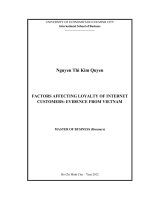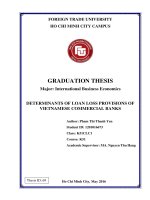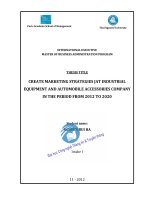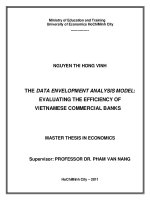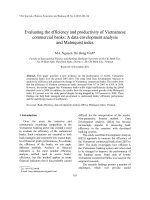Factors affecting vietnamese commercial banks’ deposit growth from 2012 to 2020
Bạn đang xem bản rút gọn của tài liệu. Xem và tải ngay bản đầy đủ của tài liệu tại đây (1.36 MB, 71 trang )
MINISTRY OF EDUCATION AND TRAINING
THE STATE BANK OF VIETNAM
HO CHI MINH CITY UNIVERSITY OF BANKING
BUI NHU Y
FACTORS AFFECTING VIETNAMESE COMMERCIAL
BANKS’ DEPOSIT GROWTH FROM 2012 TO 2020
GRADUATION THESIS
Major: Finance – Banking
Code: 7 34 02 01
HO CHI MINH CITY, NOVEMBER 2022
MINISTRY OF EDUCATION AND TRAINING
THE STATE BANK OF VIETNAM
HO CHI MINH CITY UNIVERSITY OF BANKING
Student: BUI NHU Y
Student ID: 050606180469
Grade: HQ6-GE12
FACTORS AFFECTING VIETNAMESE COMMERCIAL
BANKS’ DEPOSIT GROWTH FROM 2012 TO 2020
GRADUATION THESIS
Major: Finance – Banking
Code: 7 34 02 01
SUPERVISOR
NGUYEN THI MY HANH, PHD
HO CHI MINH CITY, NOVEMBER 2022
i
TÓM TẮT
Mục tiêu của bài nghiên cứu là xác định các nhân tố ảnh hưởng đến tăng
trưởng tiền gửi của các ngân hàng thương mại ở Việt Nam. Bài viết sử dụng 198
quan sát của 22 ngân hàng thương mại Việt Nam trong giai đoạn từ năm 2012 đến
năm 2020, với biến phụ thuộc là Tăng trưởng tiền gửi và các biến độc lập bao gồm
Khả năng sinh lời, Tăng trưởng GDP, Tỷ lệ vốn chủ sở hữu, Tỷ lệ cho vay trên tiền
gửi, Quy mô ngân hàng, Nợ xấu, tăng trưởng Cung tiền và Lạm phát. Các phương
pháp ước lượng mơ hình hồi quy gộp (Pooled OLS), mơ hình hiệu ứng cố định
(FEM), mơ hình hiệu ứng ngẫu nhiên (REM) và ước lượng tác động ngẫu nhiên
(FGLS) được sử dụng để phân tích dữ liệu. Kết quả nghiên cứu cho thấy, các biến
yếu tố kinh tế vĩ mô như tăng trưởng Cung tiền M2 và tăng trưởng GDP có tác động
nghịch đến tăng trưởng tiền gửi của các ngân hàng thương mại. Mặt khác, tỷ lệ lạm
phát đã được phát hiện là có mối quan hệ cùng chiều nhưng khơng có ý nghĩa thống
kê. Các biến đặc thù của ngân hàng như Khả năng sinh lời có mối tương quan thuận
với tăng trưởng tiền gửi, trong khi đó, quy mô ngân hàng và tỷ lệ vốn chủ sở hữu có
tác động ngược chiều đáng kể về mặt thống kê. Tỷ lệ cho vay trên tiền gửi và Nợ
xấu ảnh hưởng không đáng kể đối với tăng trưởng tiền gửi của các ngân hàng
thương mại. Cuối cùng, nghiên cứu chỉ ra rằng một môi trường kinh tế vĩ mô ổn
định là rất quan trọng để giảm tác động của tăng trưởng kinh tế và cung tiền M2 và
từ góc độ ngân hàng cụ thể, tăng khả năng sinh lời là điều cần thiết cho tăng trưởng
tiền gửi tại các ngân hàng thương mại ở Việt Nam.
Từ khóa: tăng trưởng tiền gửi, yếu tố vĩ mô, biến đặc thù ngân hàng, các
ngân hàng thương mại, Việt Nam.
ii
ABSTRACT
The purpose of this study is to determine the factors affecting deposit growth
of commercial banks in Vietnam. The paper uses 198 observations of 22
Vietnamese commercial banks from 2012 to 2020, with dependent variable Deposit
growth and independent variables including Profitability, GDP growth, Equity ratio,
Loans to Deposits ratio, Bank size, Non-performing loans, Money supply growth
and Inflation. Pooled OLS, FEM, REM and FGLS methods have been used to
analyze the data. The result of the study indicates branch macroeconomic factors
such as Money supply growth M2 and GDP growth have a significant negative
effect on Deposit growth of commercial banks. The inflation rate, on the other hand,
has been found to have a positive but statistically insignificant relationship. The
bank-specific factors indicate Profitability has a positive and significant association,
while Bank size and Equity ratio have a statistically significant negative effect on
deposit growth. Loan to Deposit ratio and Non-performing loans have no significant
relationship with deposit growth of commercial banks. Finally, the study shows that
a stable macroeconomic environment is vital to reduce the impact of economic
growth, M2 money supply and from a bank-specific perspective, increasing
profitability is essential for the growth of deposits in commercial banks in Vietnam.
Keywords: deposit growth, macroeconomic, bank-specific, commercial
banks, Vietnam.
iii
AUTHOR’S DECLARATION
I hereby confirm that this thesis entitled “FACTORS AFFECTING
VIETNAMESE COMMERCIAL BANKS’ DEPOSIT GROWTH FROM 2012 TO
2020”, is my own work, and none of this work has been published before
submission.
Ho Chi Minh City, November 2022
Bui Nhu Y
iv
ACKNOWLEDGEMENT
I would like to express my sincere thanks to the Board of Directors, Faculty
of Finance, Faculty of Banking, lecturers, officials of departments and functional
departments of Banking University of Ho Chi Minh City for helping me to equip
my knowledge, create the most favorable conditions during the study and
implementation of this thesis.
With respect and gratitude, I would like to express my gratitude to Nguyen
Thi My Hanh, PhD for encouraging, guiding, and helping me throughout the entire
process so that the thesis research process can be completed in the best way.
v
TABLE OF CONTENT
ABSTRACT ............................................................................................................... ii
AUTHOR’S DECLARATION ................................................................................. iii
ACKNOWLEDGEMENT ........................................................................................ iv
TABLE OF CONTENT ..............................................................................................v
ABBREVIATION LIST ......................................................................................... viii
LIST OF TABLES .................................................................................................... ix
LIST OF PICTURES ..................................................................................................x
CHAPTER 1. INTRODUCTION ...............................................................................1
1.1. Rationale ...........................................................................................................1
1.2. Research objectives ..........................................................................................1
1.3. Research questions ............................................................................................2
1.4. Subject and scope of the study..........................................................................2
1.4.1. Research subject ................................................................................................... 2
1.4.2. Research scope ...................................................................................................... 2
1.5. Research method ...............................................................................................2
1.6. Contribution of the thesis..................................................................................3
1.7. Structure of the thesis .......................................................................................3
CHAPTER 2. LITERATURE REVIEW ....................................................................5
2.1. Theoretical framework......................................................................................5
2.1.1. Commercial bank .................................................................................................. 5
2.1.2. Commercial Bank Deposit .................................................................................... 6
2.1.3. Factors affecting for Deposit growth .................................................................... 7
2.1.3.1. Bank size ..............................................................................................7
2.1.3.2. Profitability ..........................................................................................7
2.1.3.3. Equity ratio ...........................................................................................8
2.1.3.4. Loan to Deposit ratio ...........................................................................8
2.1.3.5. Non-performing loans ..........................................................................9
2.1.3.6. Inflation ..............................................................................................10
2.1.3.7. GDP growth .......................................................................................10
vi
2.1.3.8. Money supply growth ........................................................................11
2.2. Empirical review .............................................................................................11
2.2.1. Empirical Review from abroad ........................................................................... 11
2.2.2. Empirical Review in VietNam............................................................................ 14
CONCLUSIONS OF CHAPTER 2 ..........................................................................17
CHAPTER 3. RESEARCH METHOD ....................................................................18
3.1. Research model ...............................................................................................18
3.1.1. Research model ................................................................................................... 18
3.1.2. Research variables .............................................................................................. 19
3.2. Research hypothesis........................................................................................20
3.3. Research data ..................................................................................................21
3.4. Selection of regression model and tests ..........................................................21
3.5. Research process .............................................................................................25
CONCLUSIONS OF CHAPTER 3 ..........................................................................25
CHAPTER 4. RESEARCH RESULTS AND DISCUSSION ..................................27
4.1. Descriptive statistics .......................................................................................27
4.1.1. Check the correlation between variables ............................................................ 28
4.1.2. Multicollinearity diagnostics .............................................................................. 29
4.2. Analysis of factors affecting Deposit Growth ................................................30
4.2.1. Regression results ............................................................................................... 30
4.2.2. Model choice....................................................................................................... 31
4.2.3. Testing the hypothesis violations of the FEM .................................................... 32
4.2.3.1. Heteroskedasticity diagnostics ...........................................................32
4.2.3.2. Autocorrelation diagnostics ...............................................................32
4.2.3.3. Fix the defects of the model ...............................................................32
4.3. Discuss the influence of factors on Deposit Growth ......................................33
CONCLUSIONS OF CHAPTER 4 ..........................................................................36
CHAPTER 5. CONCLUSIONS AND RECOMMENDATIONS ............................37
5.1. Conclusions .....................................................................................................37
5.2. Recommendations ...........................................................................................38
5.3. Limitation of the study....................................................................................39
vii
CONCLUSIONS OF CHAPTER 5 ..........................................................................40
CONCLUSIONS OF THE THESIS .........................................................................42
REFERENCES ..........................................................................................................43
APPENDIX ...............................................................................................................46
viii
ABBREVIATION LIST
Abbreviati
Meaning
on
FEM
Fixed effect model
GDP
Gross domestic product
INF
Inflation
Pooled OLS
Pooled Ordinary Least Squares
REM
Random effect model
ROA
Return on asset
ROE
Return on equity
ix
LIST OF TABLES
Table 2-1: Summary previous studies .......................................................................15
Table 4-1: Descriptive statistics of variables in the regression model ......................27
Table 4-2: Correlation matrix between variables ......................................................28
Table 4-3: Test results for multicollinearity .............................................................29
Table 4-4: Summarize the results of regression analysis with DG ...........................30
Table 4-5: F-test, Breusch-Pagan and Hausman model selection for variable DG ..31
Table 4-6: The results of Heteroskedasticity diagnostics with DG ..........................32
Table 4-7: The results of Autocorrelation diagnostics with DG ...............................32
Table 4-8: DG regression model results after fixing.................................................33
Table 4-9: Summary of Hypothesis Test ..................................................................35
x
LIST OF PICTURES
Picture 1 Descriptive statistics ............................................................................... 53
Picture 2. Correlation matrix between variables .................................................... 53
Picture 3. Test results for multicollinearity............................................................ 55
Picture 4. Pooled OLS output with Deposit growth ............................................. 55
Picture 5. FEM output with ROE ........................................................................... 56
Picture 6. REM output with ROE .......................................................................... 56
Picture 7. Hausman test with ROE ........................................................................ 57
Picture 8. Breusch and Pagan Lagrangian test with ROE ...................................... 57
Picture 9. Heteroskedasticity diagnostics with Deposit growth ............................ 57
Picture 10. Autocorrelation diagnostics with Deposit growth ............................... 58
Picture 11. FGLS output with Deposit growth ...................................................... 58
1
CHAPTER 1. INTRODUCTION
1.1. Rationale
Deposits may be crucial for both developed and developing nations because
they allow depositors to earn interest on money they don't need right away.
Additionally, it gives banks a platform to direct those funds to people and
organizations that need them immediately (Boadi, Li and Lartey, 2015). According
to Jaber and Manasrah, (2017) one of the most crucial foundational components of
banks, whether Islamic or commercial, is bank deposits. A deposit is a contract
between a client and a bank whereby the client deposits money with the bank for
investment or conservation, and the bank agrees to return the money to the client
upon request at a predetermined date and under predetermined terms (Jaber and
Manasrah, 2017).
In developing countries, where the banking system contributes 40% to 50%
of gross domestic product (GDP), deposits are key to economic growth because
deposits are the basis of capital formation (Duc, N.C., & Nguyen,T.T. & Lam, P.T,
2021). The banking system creates idle financial resources by mobilizing capital
from deposits of all economic sectors, then providing this capital for production,
investment and economic development which brings profit for the bank so deposit
mobilization is the core activity of all commercial banks. Therefore, banks can earn
high profits due to deposits (Gunasekara, H.U. and Kumari, P, 2018). However,
Commercial banks cannot manage deposits without knowing and controlling the
factors affecting it. Stemming from that practical need, the author chose the topic
"Factors affecting deposits of Vietnamese commercial banks from 2012 to 2020" as
a research topic.
1.2. Research objectives
The objective of the study is to determine factors affecting deposit growth of
Vietnamese commercial banks during the period 2012 – 2020. After that, the author
2
makes implications and suggestions improve Vietnamese commercial banks’
deposit growth.
1.3. Research questions
In line with the objectives highlighted above, the two specific research
questions were formulated as follows:
Research question 1: What factors affect deposit growth of Vietnamese
commercial banks?
Research question 2: To what extent does factors affect deposit growth of
Vietnamese commercial banks?
1.4. Subject and scope of the study
1.4.1. Research subject
The subject of this study is factors affecting deposit growth in bank business.
1.4.2. Research scope
Time scope: from 2012 to 2020.
Space scope: 22 commercial banks in Vietnam.
1.5. Research method
The thesis combines both qualitative research methods and quantitative
methods. Qualitative research methods: The thesis is based on the collected data and
information, conducts comparison, from which to make comments, evaluate
research content. At the same time, the thesis uses the deductive method to argue
and explain the characteristics of each detail in the data analysis process.
Quantitative research method: Regression analysis of panel data to determine
factors affecting deposit growth of Vietnamese commercial banks, combined with
analysis including: ordinary least squares method (Pooled OLS), random effects
model (REM), fixed effects model (FEM). The thesis proceeds to build research
model, present independent variables and Dependent variables in the model, data
sources are taken from financial statements and annual reports of banks and macro
variables are taken from the General Statistics Office. In addition, the thesis also
uses methods such as synthesis, comparison, analysis, inference, description, etc in
3
order to compare with reality, consider and evaluate factors affecting deposit
growth of Vietnamese commercial banks.
1.6. Contribution of the thesis
In practical terms, the research results of the study will provide more
empirical evidence for regulators as well as commercial bank managers to
understand more about the relationship between macro factors and deposit growth
in Vietnamese commercial banks and assist regulators in making regulatory
decisions as well as suggesting to managers important policy implications in the
development of mobilized capital.
From the previous researches, it is observed that bank deposit growth was
determined by macro-economic and bank specific variables. But from their
findings, it is observed there was no generally accepted relationship between
commercial bank deposit growth and its determinants. To the knowledge of the
researcher, there were a few studies conducted in Vietnam and this study aims to fill
a gap in the research on the determinants of bank deposits in the banking industry in
Vietnam, such as macroeconomic indicators related to bank deposit creation such as
money supply rate M2.
1.7. Structure of the thesis
The research thesis will be presented in five chapters, including:
Chapter 1: Introduction
An overview of the research problem, the reason for choosing the topic, the
research problem, the research objective, the object, the research scope and the
meaning of the research.
Chapter 2: Literature review
This chapter presents the theories related to the thesis such as deposits,
deposit evaluation criteria in commercial banks' business activities and factors
affecting deposit growth in commercial banks' business activities, and a brief
overview of related studies.
Chapter 3: Research method
4
Make initial assumptions about the impact of factors on deposit growth of
commercial banks, introduce how to choose data sources, choose appropriate
research methods, and set up regression models.
Chapter 4: Research results and discussion
The study will conduct descriptive statistical analysis, analyze the
relationship between the variables and analyze the regression results to determine
the impact of the independent variables on the dependent variable.
Chapter 5: Conclusions and recommendations
Summarize the results of the study, outline the limitations of the research
topic and suggest future research directions.
5
CHAPTER 2. LITERATURE REVIEW
2.1. Theoretical framework
2.1.1. Commercial bank
Commercial banks are credit institutions that perform all banking activities
and other related business activities for profit purposes (Consolidated documents
No. 20/2018/VBHN-NHNN, the State Bank of Vietnam).
A commercial bank is a financial institution with two business functions: one
is to federally insure deposits and pay interest to depositors, and the other is to use
its charter to make loans, check cash balances, provide clearing services, and
underwrite securities (Getter, 2016). Commercial banks play a prominent role in the
modern economy by circulating financial resources (Tariq et al., 2014). Another
definition of a commercial bank is a financial intermediary that effectively channels
idle funds in the market to those who need credit to invest in valuable production,
business opportunities, and personal purposes (Tuyishime et al., 2015). Commercial
banking is further divided into public sector banking (the bank with the majority of
its stake held by the government), private sector banking (the bank with the
majority of its stake held by private individuals), and foreign banking (the bank
with its head office located in other countries outside of a nation) (Kalpana & Rao,
2017). Commercial banks establish maladjustment and impediments and contribute
to the development of the economy (Mongid et al., 2012). The operation of
commercial banks is aligned with the monetary policies of a nation, and they play
the main role of controlling cash flow given the expected rate of returns and
emissions (Erina & Lace, 2013).
In summary, the term of commercial bank used in the study is defined as a
financial institution which operates in the way of holding deposit, paying interests
to the depositors, opening credit to different economic sectors and facilitates
economic development of a country.
6
2.1.2. Commercial Bank Deposit
Commercial banks' largest liabilities are deposits with commercial banks.
According to (Kelvin, 2001), deposits make up about 75% of the liabilities of
commercial banks. Commercial banks use this liability to lend money and earn
interest on deposits, which helps them run their businesses. Therefore, if banks are
mobilizing more deposits, they will perform better. Deposits were also mentioned
by Mahendra (2005) as a foundation upon which banks thrive and expand, as well
as special items on a bank's balance sheet that set them apart from other types of
business organizations. According to E.A. Shaw (1995), the cost of intermediation
for mobilizing deposits is a very important component of the overall intermediation
cost of the banking system. Despite the challenges, deposits are crucial to the
banking industry as well as the overall economy.
Commercial bank deposits are reliant on customer deposits. According to
Keynes' theory of money demand, there are three main motives for people to hold
money: trading, hedging, and investing. To cater to these motives, commercial
banks offer different types of deposits: deposits and savings deposits. The type of
savings deposit meets the needs of people who want to save and earn more money if
the deposit is used to carry out daily transactions. Depositors in savings accounts
also have a hedging motive (Haron, S., Azmi, W. N. W., & Shafie, S., 2006).
Deposits can be viewed from the perspectives of consumers who need an income to
cover their living expenses and from the perspectives of entrepreneurs who need
money and want to keep it in reserve to carry on their businesses.
The majority of the money supply used by the public is made up of bank
deposits, and changes in the money supply have a strong positive correlation with
changes in the cost of goods and services in the economy. Deposit variability is
frequently included as one of the important determinants of portfolio strategy; the
more volatile a bank deposit is, the more liquid its mix of assets will be. Deposit
variability affects bank holdings of cash and excess reserves, the distribution of total
member bank reserves within the banking system, and thereby the path and speed of
7
monetary policy action. This is why deposits are very important for banks and, as a
result, for the economy of a country. Banks need to inflow money from the people
so that they can be able to give loans or financing to promote productivity and
economic growth and at the same time gain profit for themselves through interest or
margin applied (Ostadi, H., & Sarlak, A., 2014).
There are three different types of deposits: demand or current deposits, fixed
or time deposits or term deposits, and savings deposits. Depositors keep their
money in banks so they can use it for future endeavors. There are motivations to
save money, some of which are listed by Bhatt (1970): To cover unexpected
expenses, own a home, To finance the marriage and education of children, to plan
ahead for old age.
2.1.3. Factors affecting for Deposit growth
2.1.3.1. Bank size
The size of the bank is one of the elements that is frequently mentioned as
influencing deposit variability. According to available data, the size of the bank
affects both the quantity and diversity of ownership of individual deposit accounts
as well as the distribution of deposits by type. A bank's total assets are used as a
representation of a bank's size. Previous studies have had mixed conclusions about
the impact of bank size on bank deposits. In general, larger banks can take
advantage of economies of scale, thereby increasing their deposits. The findings of
Ünvan, Y. A., & Yakubu, I. N. (2020) and Legass, H. A., Shikur, A. A., &
Ahmed, O. M. (2021) indicated that larger banks with economies of scale and a
larger branch network are more efficient at attracting deposits than smaller banks.
However, Islam, S. N., Ali, M. J., & Wafik, A. (2019) argued that smaller banks,
while generating fewer deposits in absolute terms, had relatively higher deposit
growth rates than other Large banks, therefore, can be beneficial to small banks in
achieving higher deposit growth.
2.1.3.2. Profitability
8
Bank Profitability is an important indicator of bank performance; it
represents the rate of return a bank has. Profit can be measured as a return on asset
(ROA) or return on equity (ROE). The study uses ROA to measure the bank's
profitability. It is defined as the ratio of profit to assets. Bank deposit performance
is best measured by ROA in that ROA is not distorted by high equity multipliers
and ROA represents a better measure of the ability of a firm to generate returns on
its portfolio of assets Abebe, M. (2019).
According to the studies of Cekrezi,A. V. (2022), Thao, V. T. P. (2021),
Haddaweea, A. H., & Flayyihb, H. H. (2020), ROA variable has a positive impact
on deposit growth. For banks with high a ROA in the previous quarter, deposit
growth is faster. Higher bank profits tend to signal bank stability, which can make it
easier for these banks to attract more deposits. However, Ünvan, Y. A., & Yakubu,
I. N. (2020) discovered a negative and statistically significant relationship between
ROA and deposits.
2.1.3.3. Equity ratio
One of the measures of capital adequacy in banks is the ratio of equity to
total assets. If this ratio is high, the bank has enough capital in reserve to manage
a possible amount of loss in the future. In this case, clients will be more
confident in giving their money to the bank. The findings of Cekrezi,A. V.
(2022) reached an identical conclusion that the impact of capital adequacy ratios
on deposits is negative and significant. This suggests that banks with a greater
capitalization ratio rely less on deposits for operations. Banks make no attempts
to raise deposits. The findings of Ünvan, Y. A., & Yakubu, I. N. (2020), who
discovered a negative but insignificant correlation.
2.1.3.4. Loan to Deposit ratio
The loan-to-deposit ratio is used to assess a bank's liquidity by comparing a
bank's total loans to its total deposits for the same period. A loan-to-deposit ratio
shows a bank's ability to cover loan losses and withdrawals by its customers.The
LDR helps investors to assess the health of a bank's balance sheet. Loans given to
9
its customers are mostly not considered liquid meaning that they are investments
over a longer period of time. Although a bank will keep a certain level of mandatory
reserves, they may also choose to keep a percentage of their non-lending investing
in short term securities to ensure that any monies deeded can be accessed in the
short term loan-deposit ratio (Teshome, F., 2017).
If the ratio is less than 1, the bank did not borrow from outside sources in
order to fund loans to its customers. Instead of relying solely on its own deposits,
the bank borrowed money if the ratio was greater than 1, which it then reloaded at a
higher rate. If the ratio is too low, banks might not be making the best return
possible. The banks may not have enough liquidity to deal with any unanticipated
funding needs or economic crises if the ratio is too high. However, the high loan
amounts disbursed to customers may cause the banks' total deposits to rise. This
indicates that a large sum of money is in the hands of the populace.
According to Teshome, F. (2017) and Vong et al. (2009) study findings,
there is a positive relationship between loan-to-deposit ratio and deposit. And
another study of Islam, S. N., Ali, M. J., & Wafik, A. (2019) demonstrate that Loanto-deposit ratio had positive impact but insignificant correlation on the banks’s
deposit growth rate of the private commercial banks in Bangladesh. This implies
that the more loans we have, the more money is in the hands of the customer, which
may lead to an increase in deposit.
2.1.3.5. Non-performing loans
Bad loan (NPL) is represented by the ratio of bad debts / total outstanding
loans. Since a bank's loan portfolio carries the majority of its risk, it is crucial to
evaluate the strength and quality of the bank's assets by keeping track on the
borrower's financial situation and using the NPL ratio as a proxy for credit
quality (Baral, 2005). The credit quality declines as the NPL ratio rises.
Research on deposits in Vietnam, Thao, V. T. P. (2021) demonstrated a
negative but insignificant relationship between deposit growth and bad debt
ratios in banks.The amount of money deposited at the bank is decreased as a
10
result of the high NPL ratio, which makes depositors feel insecure when making
deposits into those banks. According to Ikuko & Konishi (2007), one of the
elements that has a detrimental impact on deposit growth is the bad loan ratio.
Deposits will decline for banks that don't adhere to the standards for sound
financial management and security.
2.1.3.6. Inflation
In many previous empirical studies, the effect of inflation was not clearly
defined; it has different effects on the deposits of commercial banks in different
research samples. In some studies, it is found that inflation has a negative
relationship with the amount of deposits. In times of high inflation, depositors need
more cash for expenses and thus leads to withdrawal action or reduces total deposit
in general. This negative relationship has been verified through the studies of
Ünvan, Y. A., & Yakubu, I. N. (2020) and Larbi-Siaw, O., & Lawer, P. A. (2015).
Meanwhile, some other empirical studies suggest that higher inflation will
lead to increased savings because depositors will be provided with higher returns,
all other things being equal. This positive relationship has been verified through the
study of Akhtar, B. (2015) for conventional bank deposits in case of Pakistan and
Legass, H. A., Shikur, A. A., & Ahmed, O. M. (2021)
2.1.3.7. GDP growth
The relationship between economic growth and deposit mobilization has
been studied extensively in the literature related to business cycles and bank
stability. Most of the results of studies showing that the growth of economic
activity, as measured by growth in the gross domestic product (GDP), has a positive
effect on deposits at banks because it is an increase in income increases, leading to
an increase in savings and investment. That means that when the economy is
growing, bank deposits increase and conversely when the economy is in recession,
bank deposits decrease. Economic growth is expected to contribute to bank deposit
growth. This positive relationship has been verified through the studies of B Akhtar
(2017), Thao, V. T. P. (2021).
11
2.1.3.8. Money supply growth
A measure of the total amount of money in an economy is the money
supply. The total of money in circulation, deposits, certificates of deposit, and
saving deposits is known as the money supply (M2). The broad definition of
cash supply (M2) is used, which includes deposits in foreign currencies, demand
deposits, quasi-money, and currency in circulation. The money-creating
activities of the deposit money banks impact directly on funds and as long as the
financial institution is liable for controlling funds in an economy, it is important
to understand the role of those banking institutions on the convergence process,
Legass, H. A., Shikur, A. A., & Ahmed, O. M. (2021). The finding of Ngula
(2012) suggests that if money supply is high people can easily find cheap funds
to finance their needs. Thus, people tend to decrease saving and increase
consumption.
According to Terefe, A. (2019), Larbi-Siaw, O., & Lawer, P. A. (2015)
and Akhtar, B. (2015) study findings, there is a negative relationship between
money supply (M2) and deposit. And another study by Legass, H. A., Shikur, A.
A., & Ahmed, O. M. (2021), Yakubu, I. N., & Abokor, A. H. (2020) and Islam,
S. N., Ali, M. J., & Wafik, A. (2019), demonstrate that money supply (M2) had
a positive impact on the bank deposit growth rate of commercial banks in
Vietnam.
2.2. Empirical review
2.2.1. Empirical Review from abroad
The influence of internal and external factors on deposit growth of
commercial banks has been studied in foreign studies and nation study. In this
section, that studies are collected in order to understand how previous research on
the topic is. The main results, data collection and data methodology are as follows:
Cekrezi,A.
V.
(2022) identified the factors that influence the level of
deposits at commercial banks in Albania. The population comprises secondary data
12
from six commercial banks operating in Albania between 2009 and 2020. The
results indicate that the coefficients of capital adequacy and remittances are
negative and significant. In contrast, the coefficient of ROA is positive and
significant. In addition, regression analysis revealed that the GDP growth rate had a
negative but not statistically significant effect on commercial bank deposits.
Legass, H. A., Shikur, A. A., & Ahmed, O. M. (2021) conducted
Determinants of commercial banks’s deposit growth evidence in Ethiopia. The
research used secondary data from 2010-2019. The researcher adopted ordinary
least square method estimation showed that branch macroeconomic factors such as
broad money supply and inflation significant positive effect on deposit growth of
commercial banks.The unemployment rate, Bank size has a positive but
insignificant relationship with deposit growth of commercial banks.
Yakubu and Abokor (2020) utilized quarterly data for the Turkish banking
system from 2000 to 2016 to demonstrate the relationship between bank deposits
and six explanatory variables, including bank stability, bank efficiency, branch
expansion, broad money supply, GDP growth, and inflation.
Ünvan and Yakubu (2020) used a random effect to examine the variables of
bank deposits in Ghana from 2008 to 2017. According to the findings, bank
profitability, bank size, liquidity ratio, and inflation are significant factors
determining bank deposit. Meanwhile, capital adequacy and monetary policy have
insignificant effect on the volume of deposit.
The study by Haddaweea, A. H., & Flayyihb, H. H. (2020) focused on
Jordanian banks from 2012 to 2016. The study indicated a substantial positive
correlation between deposits and the indicators of profitability (ROA and ROE).
Islam, S. N., Ali, M. J., & Wafik, A. (2019) studied the impact of firmsspecific variables and macroeconomic variables on the deposit mobilization of
private commercial banks in Bangladesh using panel data regression methodology.
In this study, 14 conventional private commercial banks have been observed over
ten years (2007-2016). The results of this study provide evidence that total deposit

